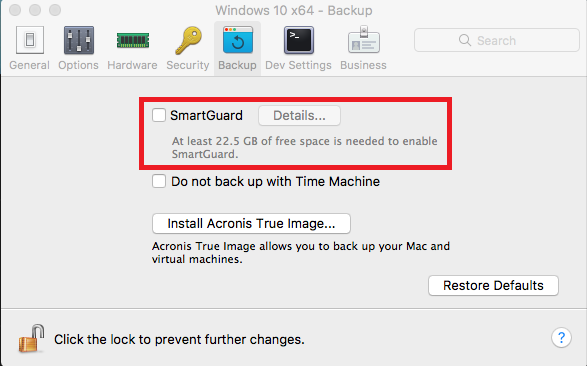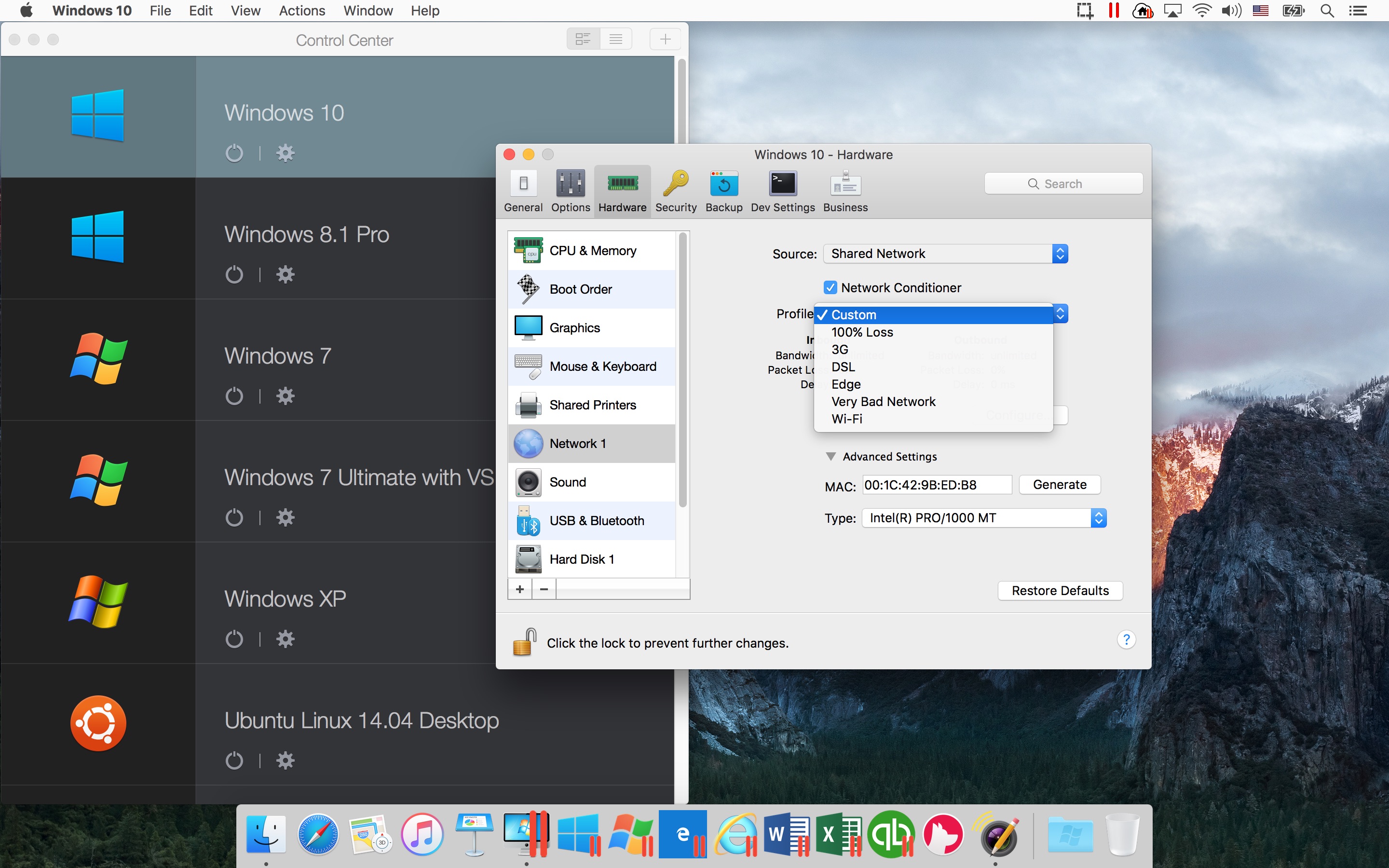Parallels Settings For Mac
Plenty of Mac users are already familiar with Parallels Desktop, which makes it easy to run virtual Windows applications on a Mac computer. IT administrators should become familiar with Parallels Desktop too, because it also comes in a business edition that provides centralized deployment and management features for Parallels Desktop on Macs across the enterprise.

Have your cake and eat it too! How to run Windows 10 on your Mac using Parallels Desktop 13 If you want to use Windows on your Mac, but don't necessarily want to partition your hard drive, you can run Windows using a virtual machine like Parallels Desktop.
In a typical installation, Parallels Desktop runs locally on a Mac and provides a virtual environment for the Windows operating system (OS). That makes it possible to run Windows-based programs either side by side with Mac-based applications or within a dedicated space isolated from the Mac environment. With Parallels Desktop for Mac Business Edition, IT administrators can centrally deploy Windows-based virtual machines (VMs) and manage their settings, while providing a secure environment for conducting business and protecting sensitive data.

Getting started with Parallels Desktop Business Edition
To get started with the business edition, organizations must acquire the necessary licensing and set up a Parallels business account to manage the license keys. Administrators can register license keys and view detailed license information in the licensing portal.
Using Parallels On Mac
A computer running Parallels Desktop automatically sends license renewal requests to the Parallels Key Administrator server, which makes that information available to the portal. From the portal, administrators can view a list of computers with active licenses, deactivate licenses on specific computers and even blacklist computers to prevent future licensing.
Preparing the Parallels Desktop VMs
An organization planning to implement Parallels Desktop for Mac Business Edition will likely want to deploy its own VMs to users, which means first creating one or more master VMs to include in the deployment package. Administrators start by setting up a Mac computer with the business edition installed, and then create and configure the Windows VM exactly as they want to deploy it.
Admins should install the Parallels Tools suite of utilities on the guest operating system to facilitate seamless operations between Mac OS X and Windows. Parallels Tools includes features such as the Mouse Synchronization Tool, which detects when the mouse input is inside the guest OS window, allowing users to go back and forth smoothly. This is also a good time to set up shared folders and user profiles, install applications and take any other steps necessary to prepare the environment for the end user.
The business edition supports a number of features not available to the Parallels Desktop basic edition, which admins can configure when setting up the master VM. For example, administrators can assign asset tags to the basic I/O system to help track and control VMs across the enterprise. They can also password-protect configuration settings, encrypt the VMs, or set an expiration date so the VMs work only for a specific period of time.
Regardless of the features they want to include, administrators should use this time to get the VM images just right. This will make the overall deployment and management processes easier going forward, and keep the user experience as painless as possible.
Deploying and updating Parallels Desktop packages
Next, administrators can download the Parallels Desktop Mass Deployment package, which includes the necessary files and instructions for installing the business edition on the local Macs, configuring the virtual environment and then adding VMs.
The configuration file (deploy.cfg) is a special script that automatically runs on Macs and controls the installation of Parallels Desktop Business Edition and VMs on the target computer. Administrators should update the script to customize their installations. This includes adding the license key to the script's licensing section. They can also configure settings such as restricting users from changing VM settings, controlling where the VM images reside, customizing the Parallels Desktop Control Center window and specifying how Parallels Desktop should check for updates.

There are also several options for how to deploy the packages. For example, admins can integrate their deployments with Microsoft System Center Configuration Manager (SCCM), which allows them to deploy Parallels Desktop packages directly from the SCCM console. Administrators can also use Apple Remote Desktop to deploy the packages from a Mac on the corporate network. In addition, they can deploy Parallels Desktop packages from the JAMF Casper Suite or IBM Endpoint Manager.
Parallels Desktop for Mac Business Edition can also link with an update server on the local network. Administrators can download available updates from Parallels to the update server, which then updates the company's Mac computers with the new version. Most admins prefer that option over the alternative, which is downloading Parallels updates for each computer via the Internet.
Making the most of Mac in the enterprise
Parallels Desktop for Mac Business Edition makes it easier than ever to integrate Windows applications on enterprise Macs. The software package also includes extensive command-line utilities, support for NetBoot and a headless mode that allows the business edition to run as a service on a central Mac computer to support remote desktop access. Parallels Desktop also provides a software developer's kit to allow further customization of the service and can support additional guest OSes including Linux, Solaris, FreeBSD, Android and Chrome.
Parallels Desktop does not guarantee that all apps will run as expected within their virtualized environments, but most do, and they usually perform well. That said, before implementing Parallels Desktop Business Edition on a mass scale, administrators should first test the applications they plan to run in the virtualized OS. They might run into a glitch here or there that they will need to address.
Even so, administrators will likely find that Parallels Desktop Business Edition takes Window/Mac interoperability to a whole new level, bringing the best of both worlds into a single desktop.
Next Steps
Parallels Access enables remote desktops on iOS
Using Parallels Management Suite for SCCM
Parallels acquires 2X Software for app publishing
Why Cisco made a big investment in Parallels
Dig Deeper on VMware virtual desktop software
Customers can interact with new VMware DaaS product at VMworld
Application virtualization breathes digital life into legacy apps
How to use two-factor authentication in Horizon View
Get to know the latest VMware Horizon 7 features
Customers can interact with new VMware DaaS product at VMworld
Application virtualization breathes digital life into legacy apps
Get to know the latest VMware Horizon 7 features
Seven VDI-related VMworld 2017 sessions to look out for
How to use two-factor authentication in Horizon View
PCoIP (PC over IP)
VMware UEM (User Environment Manager)
Best of Citrix Synergy 2017 Awards: Rules and criteria
How does VMware vRealize Operations for Horizon work?
Don't get tongue-tied with VMware terms in VDI deployments
How does VMware Horizon View licensing work?
Find the right home for each of the four VMware Horizon editions
Ensure software and hardware get along after a VDI platform upgrade
Find the right home for each of the four VMware Horizon editions
Software-only options poised to change VDI storage market
How do I use VMware vDGA?
IT shop uses VMware Fusion software to unite Windows and macOS
What's new in VMware App Volumes 3.0?
How VMware Horizon View stacks up
VMware View components: What you need and how they work
Robert Sheldon asks:
How do you provide Windows applications for Mac users?
Parallel On Mac
- Why IT Must Break Down Silos as Part of its Digital Transformation Initiative–Citrix
- How IT and HR can Partner to Deliver a Better Employee Experience–Citrix
- Why the Citrix-Microsoft Relationship Will Enhance Digital Workspace Solutions ...–Citrix
Parallels For Mac Free
- Parallels– SearchVirtualDesktop
- Parallels Desktop for Mac– SearchVirtualDesktop
- Parallels Desktop makes virtualizing Windows on a Mac...– SearchVirtualDesktop